 W
WThe Austro-Turkish War was fought between Habsburg Monarchy and the Ottoman Empire. The Treaty of Karlowitz (1699) was not an acceptable long-standing agreement for the Ottoman Empire. Twelve years after Karlowitz, the Turks began the long prospect of taking revenge for their defeat at the Battle of Vienna in 1683. First, the Turkish Grand Vizier Baltacı Mehmet's army defeated Peter the Great's Russian Army in the Russo-Turkish War (1710–1711). Thereafter, in the Ottoman–Venetian War (1714–1718), the new Grand Vizier Damat Ali re-conquered the Morea from the Venetians in 1715. As a reaction, Austria, as the guarantor of the Treaty of Karlowitz, threatened the Ottoman Empire, but in response, the Ottoman Empire declared war against Austria.
 W
WThe Battle of Petrovaradin took place on 5 August 1716 during the Austro-Turkish War, after the Ottoman army began to lay siege to the Habsburgs-controlled fortress of Petrovaradin on the Military Frontier of the Habsburg Monarchy. The Ottomans, prepared to capture Petrovaradin, the so-called Gibraltar on the Danube, experienced a heavy defeat by an army half the size of their own, similar to the defeat they had experienced in 1697 at Zenta. Ottoman Grand Vizier Damad Ali Pasha was fatally wounded, the Ottoman army lost 20,000 men and 250 guns to a Christian army, made mostly of veterans from the Flanders campaign, led by Field Marshal Prince Eugene of Savoy. The Austrians consolidated this victory by marching into the Banat and besieging Temesvár the last remaining Turkish fortress in Hungary followed by Belgrade.
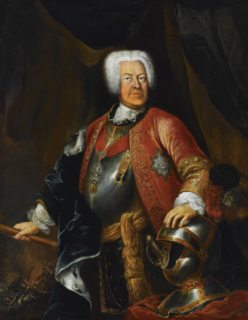 W
WCharles Alexander of Württemberg was a Württemberg noble from 1698 who governed the Kingdom of Serbia as regent from 1720 until 1733, when he assumed the position of Duke of Württemberg, which he held until his death.
 W
WPrince Eugene Francis of Savoy–Carignano better known as Prince Eugene was a field marshal in the army of the Holy Roman Empire and of the Austrian Habsburg dynasty during the 17th and 18th centuries. He was one of the most successful military commanders of his time, and rose to the highest offices of state at the Imperial court in Vienna.
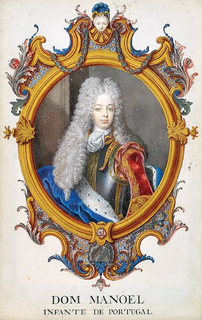 W
WInfante Manuel, Count of Ourém, KGF ([mɐnuˈɛɫ]; Manuel José Francisco António Caetano Estêvão Bartolomeu; was a Portuguese infante, seventh child of Peter II, King of Portugal, and his wife Maria Sophia of Neuburg. He was the brother of King John V of Portugal. He was a candidate for the Polish throne.
 W
WCount Claudius Florimund de Mercy was an Imperial field marshal, born at Longwy in Lorraine, now in France. His grandfather was the Bavarian field marshal Franz Freiherr von Mercy.
 W
WJohann Bernhard Stephan, Graf Pálffy de Erdőd was a Hungarian noble, Imperial Field marshal and Palatine of Hungary. A troop commander at the time of Prince Eugène of Savoy, he distinguished himself in Italy and against the Kuruc invasions, concluded the Peace of Szatmár and fought in the Turkish War most notably at Peterwardein and at Belgrade. In 1703 he became Ban of Croatia and in 1740 placed the Hungarian royal crown on Maria Theresa. János Pálffy was renowned for his strong loyalty to the Habsburgs and his extraordinary bravery in battle.
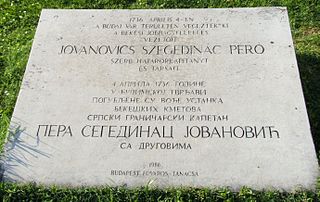 W
WPetar Jovanović, known as Pera Segedinac, was a Habsburg Serb military officer, a captain in Pomorišje. He led a Serb revolt in 1735.
 W
WMaurice, Count of Saxony was a notable soldier, officer and a famed military commander of the 18th century. The son of Augustus II the Strong, King of Poland and Elector of Saxony, he initially served in the Army of the Holy Roman Empire, then the Imperial Army before finally entering French service. De Saxe became a Marshal and even Marshal General of France. He is best known for his deeds in the War of the Austrian Succession and for his decisive victory at the Battle of Fontenoy especially. He is honoured by the Walhalla Memorial.
 W
WThe Kingdom of Serbia was a province (crownland) of the Habsburg Monarchy from 1718 to 1739. It was formed from the territories to the south of the rivers Sava and Danube, corresponding to the Sanjak of Smederevo, conquered by the Habsburgs from the Ottoman Empire in 1717. It was abolished and returned to the Ottoman Empire in 1739.
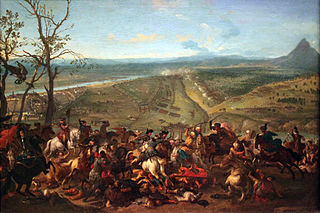 W
WThe Siege of Belgrade was a successful attempt by Austrian troops under the command of Prince Eugene of Savoy to capture the strategically important city of Belgrade from the Ottoman Empire. It took place during the Austro-Venetian-Ottoman war (1714–1718), barely a year after the Austrian victory at the Battle of Petrovaradin (Peterwardein). The Austrians routed the Ottoman relief army under Grand Vizier Hacı Halil Pasha on 16 August. As a consequence, the Belgrade garrison, deprived of relief, surrendered to the Austrians on 21 August. The Ottoman Sultan Ahmed III sued for peace, resulting in the Treaty of Passarowitz a year later, which completed the transfer of the remainder of Hungary, the Banat and the city of Belgrade into Austrian hands.
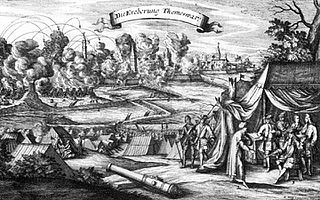 W
WThe Siege of Temeşvar took place from 31 August to 12 October 1716 during the Austro-Turkish War. The Habsburg army led by Prince Eugene of Savoy, who had just won a crushing victory at Petrovaradin, managed to capture the fortress of Temeşvar an Ottoman stronghold since 1552, the capital of the Banat and the last Turkish stronghold in Hungary. The garrison capitulated after a 43 days siege. The city remained under military administration until 6 June 1778, when it was handed over to the administration of the Kingdom of Hungary.
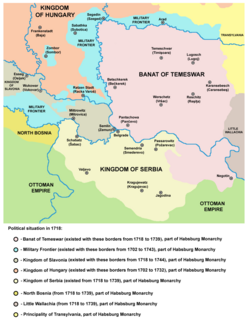 W
WThe Treaty of Passarowitz or Treaty of Požarevac was the peace treaty signed in Požarevac, a town in the Ottoman Empire, on 21 July 1718 between the Ottoman Empire on one side and Austria of the Habsburg Monarchy and the Republic of Venice on the other.